Neck (water spirit)
The neck, nicor, nokk, nix,[1] nixie,[1] nixy,[1] or nokken (German: Nixe; Dutch: nikker, nekker; Danish: nøkke; Norwegian Bokmål: nøkk; Nynorsk: nykk; Swedish: näck; Faroese: nykur; Finnish: näkki; Estonian: näkk) are shapeshifting water spirits in Germanic mythology and folklore who usually appeared in the form of other creatures.
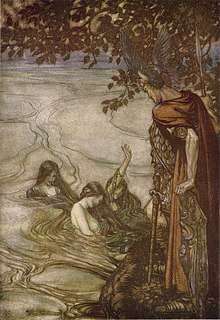 The Rhine Maidens Warn Siegfried (1912) by Arthur Rackham | |
| Grouping | Legendary creature |
|---|---|
| Other name(s) | Nicor, Nixie or Nokken |
| Region | Europe |
Under a variety of names, they were common to the stories of all Germanic peoples,[2] although they are perhaps best known from Scandinavian folklore. The related English knucker was generally depicted as a wyrm or dragon, although more recent versions depict the spirits in other forms. Their sex, bynames, and various transformations vary geographically. The German Nix and his Scandinavian counterparts were male. The German Nixe was a female river mermaid.[2]
Names and etymology
2.jpg)
The names are held to derive from Common Germanic *nikwus or *nikwis(i), derived from PIE *neigw ("to wash").[3] They are related to Sanskrit nḗnēkti, Greek νίζω nízō and νίπτω níptō, and Irish nigh (all meaning to wash or be washed).[4] The form neck appears in English and Swedish (näck or nek, meaning "nude").[4] The Swedish form is derived from Old Swedish neker, which corresponds to Old Icelandic nykr (gen. nykrs), and nykk in Norwegian Nynorsk.[4] In Finnish, the word is näkki. In Old Danish, the form was nikke and in modern Danish and Norwegian Bokmål it is nøkke/nøkk.[4] The Icelandic and Faroese nykur are horselike creatures. In Middle Low German, it was called necker and in Middle Dutch nicker (compare also Nickel or Nikkel plus Kobolt) .[4] The Old High German form nihhus also meant "crocodile",[2][4] while the Old English nicor[2][4] could mean both a "water monster" like those encountered by Beowulf,[5] and a "hippopotamus".[4] The Norwegian Fossegrim and Swedish Strömkarlen are related figures sometimes seen as by-names for the same creature.[4] The southern Scandinavian version can transform himself into a horse-like kelpie, and is called a Bäckahästen (the "brook horse"), whilst the Welsh version is called the Ceffyl Dŵr (the "water horse").
England
English folklore contains many creatures with similar characteristics to the Nix or Näck. These include Jenny Greenteeth, the Shellycoat, the river-hag Peg Powler, the Bäckahäst-like Brag, and the Grindylow.
At Lyminster, near Arundel in the English county of Sussex, there are today said to dwell "water-wyrms" called knuckers, in a pool called the Knucker-hole. The great Victorian authority Skeat had plausibly suggested the pool's name of knucker (a name attested from 1835, Horsfield)[6] was likely derived from the Old English nicor, a creature-name found in Beowulf.[7] Yet the waters at the pool were badly muddied by a local antiquarian named Samuel Evershed, who from 1866 tried assiduously to connect the pool with dragons and thus with the tale of St. George and the Dragon. Any authentic water-sprite folklore the site may originally have had was thus trampled down by Evershed's enthusiastic inculcation of the local people in ideas about water-dragons.
Scandinavia
Näck, Nøkk
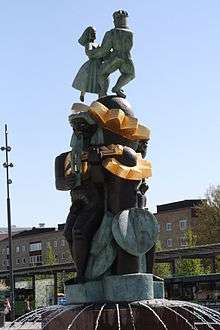
The Scandinavian näcken, näkki, nøkk were male water spirits who played enchanted songs on the violin, luring women and children to drown in lakes or streams. However, not all of these spirits were necessarily malevolent; many stories indicate at the very least that nøkker were entirely harmless to their audience and attracted not only women and children, but men as well with their sweet songs. Stories also exist wherein the Fossegrim agreed to live with a human who had fallen in love with him, but many of these stories ended with the nøkk returning to his home, usually a nearby waterfall or brook. (Compare the legend of Llyn y Fan Fach in Wales.) The nøkker were said to grow despondent unless they had free, regular contact with a water source.
The Norwegian Fossegrim or Grim, Swedish strömkarl,[8] is a related figure who, if properly approached, will teach a musician to play so adeptly "that the trees dance and waterfalls stop at his music".[9]
It is difficult to describe the appearance of the nix, as one of his central attributes was thought to be shapeshifting. Perhaps he did not have any true shape. He could show himself as a man playing the violin in brooks and waterfalls (though often imagined as fair and naked today, in folklore he was more frequently described as wearing more or less elegant clothing) but also could appear to be treasure or various floating objects, or as an animal—most commonly in the form of a "brook horse" (see below). The modern Scandinavian names are derived from Old Norse nykr, meaning "river horse". Thus, it is likely that the figure of the brook horse preceded the personification of the nix as the "man in the rapids". Fossegrim and derivatives were almost always portrayed as especially beautiful young men, whose clothing (or lack thereof) varied widely from story to story.
The enthralling music of the nøkk was most dangerous to women and children, especially pregnant women and unbaptised children. He was thought to be most active during Midsummer's Night, on Christmas Eve, and on Thursdays. However, these superstitions do not necessarily relate to all the versions listed here. Many, if not all of them, developed after the Christianizing of the northern countries, as was the case of similar stories of faeries and other entities in other areas.
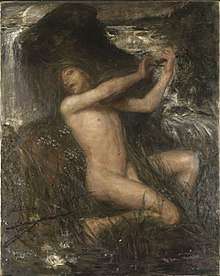
When malicious nøkker attempted to carry off people, they could be defeated by calling their name; this was believed to cause their death.[10]
Another belief was that if a person bought the nøkk a treat of three drops of blood, a black animal, some brännvin (Scandinavian vodka) or snus (wet snuff) dropped into the water, he would teach his enchanting form of music.
The nøkk was also an omen for drowning accidents. He would scream at a particular spot in a lake or river, in a way reminiscent of the loon, and on that spot, a fatality would later take place. He was also said to cause drownings, but swimmers could protect themselves against such a fate by throwing a bit of steel into the water.[11]
In the later Romantic folklore and folklore-inspired stories of the 19th century, the nøkk sings about his loneliness and his longing for salvation, which he purportedly never shall receive, as he is not "a child of God". In a poem by Swedish poet E. J. Stagnelius, a little boy pities the fate of the nøkk, and so saves his own life. In the poem, arguably Stagnelius' most famous, the boy says that the Näck (nøkk) will never be a "child of God" which brings "tears to his face" as he "never plays again in the silvery brook".
On a similar theme, a 19th-century text called "Brother Fabian's Manuscript" by Sebastian Evans has this verse:
(The source has "bloometh" for "boometh", but this is clearly an error; a bittern is not a plant, but a bird, and it is known for its booming call. A "ghittern" is a guitar. The spelling "Nickar" vice "Neckar" is sometimes used.)
In Scandinavia, water lilies are called "nix roses" (näckrosor/nøkkeroser). A tale from the forest of Tiveden relates that a father promised his daughter to a nøkken who offered him great hauls of fish in a time of need; she refused and stabbed herself to death, staining the water lilies red from that time on:
At the lake of Fagertärn, there was once a poor fisherman who had a beautiful daughter. The small lake gave little fish and the fisherman had difficulties providing for his little family. One day, as the fisherman was fishing in his little dugout of oak, he met the Nøkken, who offered him great catches of fish on the condition that the fisherman gave him his beautiful daughter the day she was eighteen years old. The desperate fisherman agreed and promised the Nøkken his daughter. The day the girl was eighteen she went down to the shore to meet the Nøkken. The Nøkken gladly asked her to walk down to his watery abode, but the girl took forth a knife and said that he would never have her alive, then stuck the knife into her heart and fell down into the lake, dead. Then, her blood coloured the water lilies red, and from that day the water lilies of some of the lake's forests are red.[12]
In horse form

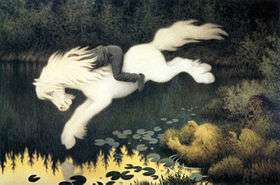
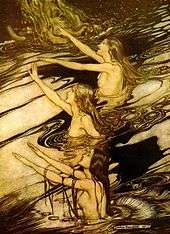
In Faroese, the word nykur refers specifically to a supernatural horse, described in one Faroese text thus:
The nykur dwells in water; at the bottom, down in the depths, he has his lair; from here he often goes onto land and it is not good to meet him.
Sometimes he is like a beautiful little horse which seems to be good and tame, and thus he lures people to draw near to him to pat him and stroke him along the back. But when they come to touch the tail, they become stuck fast to him and then he releases no-one, but he drags them with him to the bottom of the water.
Sometimes he encounters people in human form, as a handsome youth, to lure young women to himself, and promises them joy and gladness in his hall if they want to go along with him. But if they get a suspicion of who he is, when they are giving themselves away, such that they can call him by his true name — nykur — then he loses the power over them and must release them and go along into his waters.
It is said that the nykur can equally well change itself into the form of all quadrupedal animals, except that he does not know how to create the horn-points of a ram or a male lamb on himself.
But when he hasn't changed his form, he is like a horse, and it has come about that people gain power over him by carving a cross into his back and then they have been able to have him drag great stones by his tail down from the mountains to homesteads or houses. Some are still seen in Húsavík in Sandoy and on Eiði in Eysturoy and the big rocks that are gathered together there bear witness to how strong he is. At Takmýri in Sandoy, lies one huge rock, which they wanted to have him draw to Húsavík, but his tail broke here, and the stone remains there. One part of the nykur's tail, which was attached to the stone, is visible on it still.[13]
The equivalent term in Continential Scandinavian languages is bäckahäst or bækhest ('brook horse'). It has a close parallel in the Scottish kelpie, and the Welsh Ceffyl Dŵr.
The bäckahäst was often described as a majestic white horse that would appear near rivers, particularly during foggy weather. Anyone who climbed onto its back would not be able to get off again. The horse would then jump into the river, drowning the rider. The brook horse could also be harnessed and made to plough, either because it was trying to trick a person or because the person had tricked the horse into it. The following tale is a good illustration of the brook horse:
A long time ago, there was a girl who was not only pretty but also big and strong. She worked as a maid on a farm by Lake Hjärtasjön in southern Nerike. She was ploughing with the farm's horse on one of the fields by the lake. It was springtime and beautiful weather. The birds chirped and the wagtails flitted in the tracks of the girl and the horse in order to pick worms. All of a sudden, a horse appeared out of the lake. It was big and beautiful, bright in colour and with large spots on the sides. The horse had a beautiful mane which fluttered in the wind and a tail that trailed on the ground. The horse pranced for the girl to show her how beautiful he was. The girl, however, knew that it was the brook horse and ignored it. Then the brook horse came closer and closer and finally he was so close that he could bite the farm horse in the mane. The girl hit the brook horse with the bridle and cried: "Disappear you scoundrel, or you'll have to plough so you'll never forget it." As soon as she had said this, the brook horse had changed places with the farm horse, and the brook horse started ploughing the field with such speed that soil and stones whirled in its wake, and the girl hung like a mitten from the plough. Faster than the cock crows seven times, the ploughing was finished and the brook horse headed for the lake, dragging both the plough and the girl. But the girl had a piece of steel in her pocket, and she made the sign of the cross. Immediately she fell down on the ground, and she saw the brook horse disappear into the lake with the plough. She heard a frustrated neighing when the brook horse understood that his trick had failed. Until this day, a deep track can be seen in the field.[14]
Germany
The German Nix and Nixe (and Nixie) are types of river merman and mermaid who may lure men to drown, like the Scandinavian type, akin to the Celtic Melusine and similar to the Greek Siren. The German epic Nibelungenlied mentions the Nix in connection with the Danube, as early as 1180 to 1210.
Nixes in folklore became water sprites[15] who try to lure people into the water. The males can assume many different shapes, including that of a human, fish, and snake. The females bear the tail of a fish. When they are in human forms, they can be recognised by the wet hem of their clothes. The Nixes are portrayed as malicious in some stories but harmless and friendly in others.
By the 19th century Jacob Grimm mentions the Nixie to be among the "water-sprites" who love music, song and dancing, and says "Like the sirens, the Nixie by her song draws listening youth to herself, and then into the deep."[15] According to Grimm, they can appear human but have the barest hint of animal features: the nix had "a slit ear", and the Nixie "a wet skirt". Grimm thinks these could symbolise they are "higher beings" who could shapeshift to animal form.[16]
One famous Nixe of recent German folklore, deriving from 19th-century literature, was Lorelei; according to the legend, she sat on the rock at the Rhine which now bears her name, and lured fishermen and boatmen to the dangers of the reefs with the sound of her voice. In Switzerland there is a legend of a sea-maid or Nixe that lived in Lake Zug (the lake is in the Canton of Zug).
The Yellow Fairy Book by Andrew Lang includes a story called "The Nixie of the Mill-Pond" in which a malevolent spirit that lives in a mill pond strikes a deal with the miller that she will restore his wealth in exchange for his son. This story is taken from the Tales of Grimm.
The legend of Heer Halewijn, a dangerous lord who lures women to their deaths with a magic song, may have originated with the Nix.
Alternate names (kennings) for the female German Nixe are Rhine maidens (German: Rheintöchter) and Lorelei.
In a fictional depiction, the Rhine maidens are among the protagonists in the four-part Opera Der Ring des Nibelungen by the composer Richard Wagner, based loosely on the nix of the Nibelungenlied.
The Rhine maidens Wellgunde, Woglinde, and Floßhilde (Flosshilde) belong to a group of characters living in a part of nature free from human influence. Erda and the Norns are also considered a part of this 'hidden' world.
They are first seen in the first work of the Nibelungen cycle, Das Rheingold, as guardians of the Rheingold, a treasure of gold hidden in the Rhein river. The dwarf Alberich, a Nibelung, is eager to win their favour, but they somewhat cruelly dismiss his flattery. They tell him that only one who is unable to love can win the Rheingold. Thus, Alberich curses love and steals the Rheingold. From the stolen gold he forges a ring of power. Further on in the cycle, the Rhine maidens are seen trying to regain the ring and transform it back into the harmless Rheingold. But no one will return the ring to them; not even the supreme god Wotan, who uses the ring to pay the giants Fasolt and Fafner for building Valhalla, nor the hero Siegfried, when the maidens appear to him in the third act of Götterdämmerung. Eventually Brünnhilde returns it to them at the end of the cycle, when the fires of her funeral pyre cleanse the ring of its curse.
Descendants of German immigrants to Pennsylvania sometimes refer to a mischievous child as being "nixie".
In fiction
In the 2019 film Frozen II, Queen Elsa of Arendelle encounters and tames the Nøkk, the Water spirit who guards the sea to the mythical river Ahtohallan.[17]
Notes
- "Nix". Encyclopædia Britannica. Retrieved 24 June 2019.
- The article Näcken, tome 20, p. 317, in Nordisk familjebok (1914)
- Köbler, Gerhard. "Indogermanisches Wörterbuch" (PDF). Archived from the original (PDF) on 12 January 2012. Retrieved 26 December 2011.
- Hellquist, Elof (1922). "Svensk etymologisk ordbok". Lund: C. W. K. Gleerups förlag Berlingska boktryckeriet. p. 532. Retrieved 26 December 2011.
- Kemble, John Mitchell (1837). Beowulf: A Translation of the Anglo-Saxon Poem of Beowulf. pp. 17–.
- Thomas Walker Horsfield, The History, Antiquities, and Topography of the County of Sussex, Volume 2, 1835.
- Dragons & Serpents In Sussex Archived 5 April 2008 at the Wayback Machine
- Or strömkarl (singular), per Grimm 1835:17:11.
- "The Fairy Mythology: Scandinavia : The Power of the Harp". Sacred-texts.com. Retrieved 26 December 2011.
- Francis James Child, The English and Scottish Popular Ballads, v 1, p 95-6, Dover Publications, New York 1965.
- "Phantoms of the Deep, or : Legends and Superstitions of the Sea and of Sailors". Retrieved 3 September 2013.
- Karlsson 1970:86
- "Nykurin býr í vøtnum, á botninum niðri í dýpinum hevur hann sítt tilhald, men haðan fer hann ofta á land, og honum er ikki gott at møta. Stundum er hann líkur einum vøkrum lítlum hesti, sum tykist at vera góður og spakur, og harvið lokkar hann fólk at nærkast til sín at klappa honum og strúka honum eftir baki. Men tá tey koma at nerta við halan, verða tey áføst við hann, og tá sleppur hann ongum, men dregur tey við sær til botns í vatninum. Stundum møtir hann fólki í manslíki sum ein prúður unglingi at lokka gentur við sær og lovar teimum gleði og gaman í síni høll, um tær vilja fylgja honum eftir. Men fáa tær illgruna um, hvør hann er, sum tær eru við at geva seg burtur til, so at tær fáa nevnt hann við rætta navni: "nykur", missir hann maktina yvir tær og má sleppa teimum og fara einsumallur í vatn sítt. Tað er sagt, at nykurin kann líkaleiðis umskapa seg líkan øllum ferføttum djórum, uttan stikulin av veðra- ella veðurlambshorni skal hann ikki kunna skapa á seg. Men rossi er hann líkur, tá ið hann ikki hevur broytt ham sín, og tað hevur borið monnum til at fáa vald yvir hann við at rista kross á baki á honum, og hava teir tá havt hann til at draga við halanum stórt grót oman úr fjøllum til gerðisgarðar ella hús, sum enn sæst í Húsavík í Sandoy og á Eiði í Eysturoy, og tað stóra grótið, ið har er saman komið, ber vitni um, hvussu sterkur hann er. Á Takmýrum í Sandoy liggur ein stórur klettur, sum teir vildu hava hann at draga til Húsavíkar, men har slitnaði halin, og steinurin stendur har. Ein partur av nykarhalanum, sum var áfastur við steinin, er sjónligur á honum enn." V. U. Hammershaimb, Færøsk Anthologi (Copenhagen, 1891).
- Hellström 1985:16
- Grimm 1835:17:11.
- Grimm 1835:33:2.
- Allen, Ben. "Trolls, Nokks and Joik singing: the Nordic cultural artefacts that inspired Frozen 2". radiotimes.com. Retrieved 9 April 2020.
References
- Riordan, Rick (2017). Magnus Chase and the gods of Asgard: The Ship of the Dead
- Grimm, Jacob (1835). Deutsche Mythologie (German Mythology); From English released version Grimm's Teutonic Mythology (1888); Available online by Northvegr 2004–2007: Chapter 17, page 11; Chapter 33, page 2. File retrieved 4 June 2007.
- Hellström, AnneMarie (1985). Jag vill så gärna berätta.... ISBN 91-7908-002-2.
- Karlsson, S. (1970). I Tiveden, Reflex, Mariestad.

External links
| Wikimedia Commons has media related to Nixes. |
- The Watersprite, an amateur translation (no rhyme, no meter) of Stagnelius's poem.
- Manxnotebook
- Sacred-Texts.com
- Scandinavian Folklore
